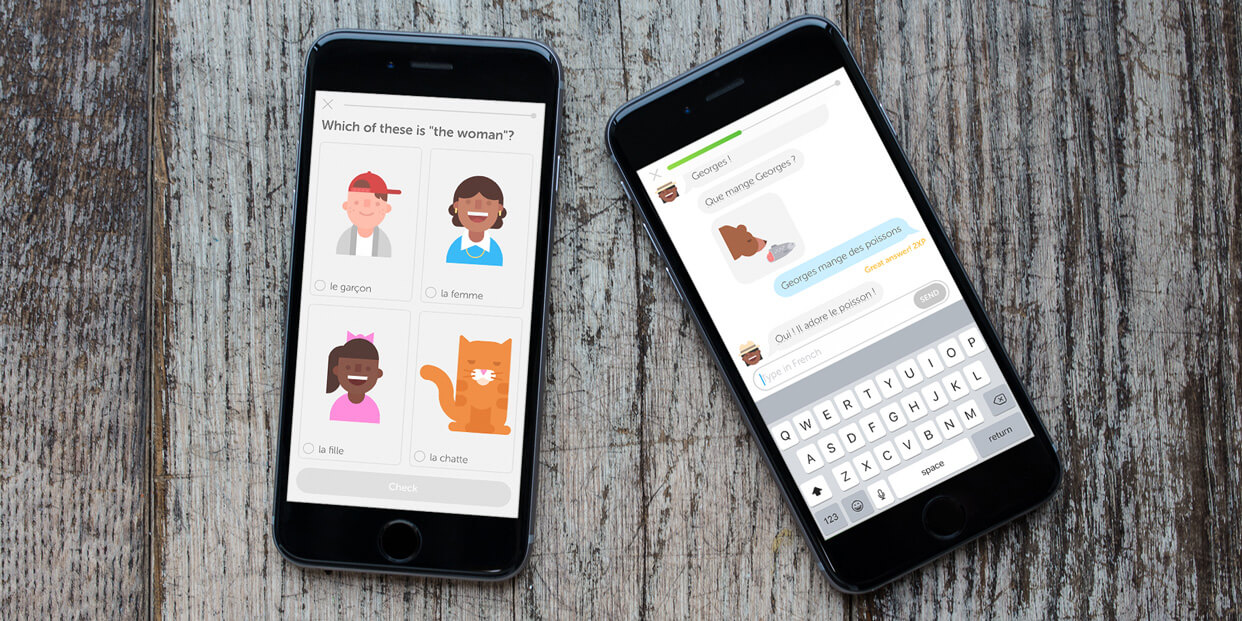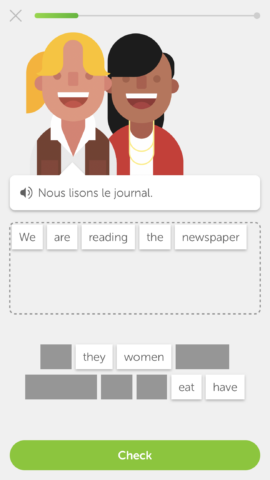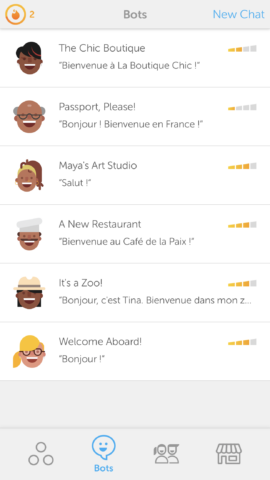Price: Free
Version: 6.1.0
Size: 153 MB
Platform: iPhone and iPad
Developer: Duolingo
Update! Duolingo was already well established when we reviewed it in 2016, but is it still the leader of the pack in 2021?
So what’s new? It’s no surprise that Duolingo now offers a premium subscription for ad removal and unlimited lessons, but there’s still a ton you can do for free. The whole system feels more ‘gamified’ than ever, with experience points, unlockable achievements, and social leaderboards. There’s much more audio content now – especially for the French language – addressing a concern we had in our original review. Meanwhile, the AI chatbot feature has evolved into interactive ‘stories’ which work really nicely. In fact, there’s loads more to discover all around; Duolingo even launched a Spanish language true crime podcast last year. Remarkably, though, it still feels extremely accessible despite those added layers of complexity.
Revised rating: These days, there’s a lot more choice on the App Store – but if this style of learning works for you, it’s worth the cost of entry. ★★★★½
—–
Our original review of Duolingo version 5.0.1, written in November 2016, is presented in its entirety below.
You’ve probably heard of Duolingo. It’s one of the biggest names on the App Store; the go-to app for people looking to add another language to their repertoire. It’s helped tens of millions of people become multi-linguists, for free, and it’s no secret that it’s really quite good – so why review it now? Because robots, that’s why.
As of Duolingo’s recent update, you can now speak to artificially intelligent chat bots to practice your conversational skills. Whoa. So in addition to learning words and phrases in an abstract way, you can put your knowledge to the test without fear of embarrassing yourself in front of a native speaker. Or having to find one. Before we delve into the future, though, let’s step back and recap the main aspects of Duolingo…
After picking a language to learn and a practice goal (between 5 and 20 minutes per day) you’re dumped straight into the lessons. The content starts basic: foods, animals, people, the usual. If you’re confident with that stuff already you can take a test to skip straight onto the more advanced lessons, which is a nice touch.
The lessons themselves are a quick-fire affair, simplifying translations into multiple choice or drag and drop sentence-building. Sometimes you’ll need to type a response manually to prove you’ve been paying attention, and there are occasional speaking and listening questions that involve the microphone. (You can skip these if you’re in public and don’t want to look like a loon.)
New words are introduced slowly, with grammatical concepts explained casually as they become relevant. It’s intuitive, it’s repetitive, and it seems to work. Importantly, Duolingo really makes you feel as though you’re making progress, which encourages you to keep going.
What really makes it addictive is that each completed lesson rewards you with experience points, just like a computer game might. Reaching certain milestones is rewarded, as is building an unbroken daily practice streak, and you can compare progress with your friends. By design, it all feels quite gamey, successfully tapping into basic psychological impulses to keep you training.
Now for the bots. There are a few of them, each with different personalities and professions, and talking to them looks and feels more or less like a regular text message conversation. The chats aren’t a complete free-for-all, though; they’re more focused, led by the bot and only accepting words related to the current topic. This helps avoid the generic “I don’t understand!” responses so common with chat bots, and keeps things nicely on track, but it could be frustrating for more adventurous conversationalists.
Tapping any foreign word flashes up a translation in English, and the app’s multi-lingual autofill helps you find the right spelling for a word even if you only half-remember it. These features help keep the chat from becoming frustrating, and beginners especially will be pleased to know there’s a “help me reply” button if you’re feeling lost or just want some suggestions of more complex answers.
The responses are generally pretty impressive, though occasionally they miss the mark – the chef bot apologizing after being told his sandwich was delicious, for example. Duolingo promises the bots will improve through usage, though, and we fully expect these minor issues to be ironed out in time.
Though Duolingo’s regular courses span a whopping 23 languages, presently its bots can only speak French, German, and Spanish. It’s also worth noting that you can’t jump straight into a bot chat – you have to unlock the feature by passing a few basic lessons, which takes about an hour if you blast through them in one sitting.
AI chat bots are all the rage right now, and they’re only going to get smarter. Currently Duolingo’s chat is text-based only, but the devs are supposedly working on a spoken version for a future update. The feature is a great addition to an already very useful app, and feels like more than just novelty. Despite a few teething problems, these bots are fun to talk to. And in the education industry, that might be the most important tool of all. C’est fantastique!





